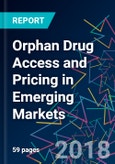This analysis covers the four major emerging regions of the Middle East and Africa, Latin America, Eastern Europe, and Asia-Pacific. Within these regions, relatively wealthier markets with a proven marketplace for orphan medicines have been prioritized.
The topic focus is on rare-disease policy, access, and pricing, as well as the stakeholder landscape for low-prevalence disorders and orphan drugs. For the purposes of this analysis, local definitions for rare disease were used where available, as well as conventional definitions of both “ultra-orphan” disorders and rare tumor types.
The insights in this analysis are aimed at a general audience within the market access and pricing field, with a limited amount of disease-specific information. In this review, key market access customers for rare diseases in 20 emerging markets have been analyzed, as well as pricing and funding pathways where these specifically relate to orphan drugs.
The topic focus is on rare-disease policy, access, and pricing, as well as the stakeholder landscape for low-prevalence disorders and orphan drugs. For the purposes of this analysis, local definitions for rare disease were used where available, as well as conventional definitions of both “ultra-orphan” disorders and rare tumor types.
The insights in this analysis are aimed at a general audience within the market access and pricing field, with a limited amount of disease-specific information. In this review, key market access customers for rare diseases in 20 emerging markets have been analyzed, as well as pricing and funding pathways where these specifically relate to orphan drugs.
Table of Contents
EXECUTIVE SUMMARY
KEY FEATURES OF EMERGING ORPHAN DRUG MARKETS
RARE DISEASE POLICY AND CAPABILITY
PRICING, REIMBURSEMENT, AND MARKET ACCESS
PRIORITY EMERGING ORPHAN DRUG MARKETS
APPENDIX
LIST OF FIGURES
LIST OF TABLES








